Sightings, Accounts, and Evidence


"My Escape From A Sea Monster!" The Pensacola Sea Serpent Encounter of 1962 |
![]()
On
July 30, 1915, the British steamer Iberian was torpedoed by a German
submarine. As it sank beneath the waves, its boilers exploded and a struggling,
writhing creature was catapulted out of the water. The officers in the
conning tower of the submarine saw the animal and couldn't match it with
any known species. They described it as "about 60 feet long, like a crocodile
in shape, and having four limbs with powerful webbed feet, and a long tail
tapering to a point". This matches the description of a Tylosaurus - a type of reptilian sea lizard and supposedly extinct for 100 million
years (Dinosaurs By Design by Dr. Duane Gish, p.87).
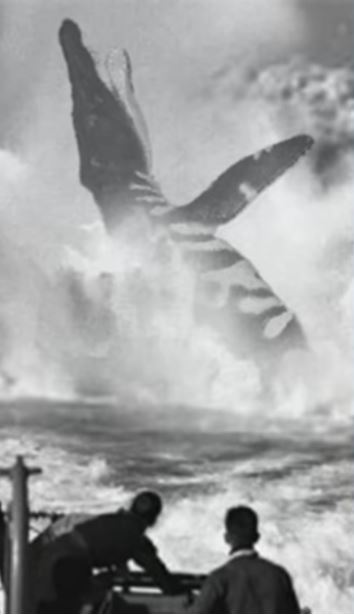
![]()
A fossil fish called
a Coelacanth has been found by archaeologists in the fossil record,
and which evolutionists once claimed died out millions of years ago. To
their embarrassed astonishment, one was caught in a fishing net in deep
water in 1938 off the east coast of Africa, and since then many more have
been caught off the coast of the Comoros Islands. Thought by evolutionists
to have evolved legs from fins and to have eventually crawled out of the
ocean to become land reptiles, they have not evolved in the slightest,
and they today appear exactly as they do in the fossil record. Incidentally,
this is in perfect accord with the theory of creation.
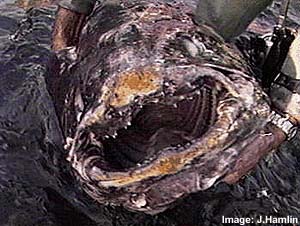
|
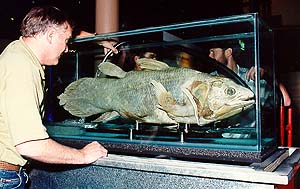
|
So many reports and sightings of plesiosaur-like sea creatures come from lakes, lochs, and oceans that a book could be written just on these sightings. Such sea creatures have been sighted in modern times in all the continents except the poles. The United States, Canada, South America, multiple African countries, Britain, China, Norway, New Guinea, and Australia all have their sightings of "prehistoric" sea creatures.

![]()
A curious petroglyph was discovered at Peterborough, near Toronto in Ontario, Canada, dated around the year 1700 B.C. It bears a striking resemblance to a type of whale-like aquatic animal called "zeuglodonts" - extremely elongated sea creatures, now extinct. This could be the oldest illustration of a sea monster.
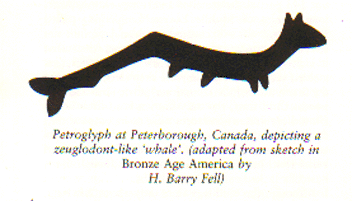
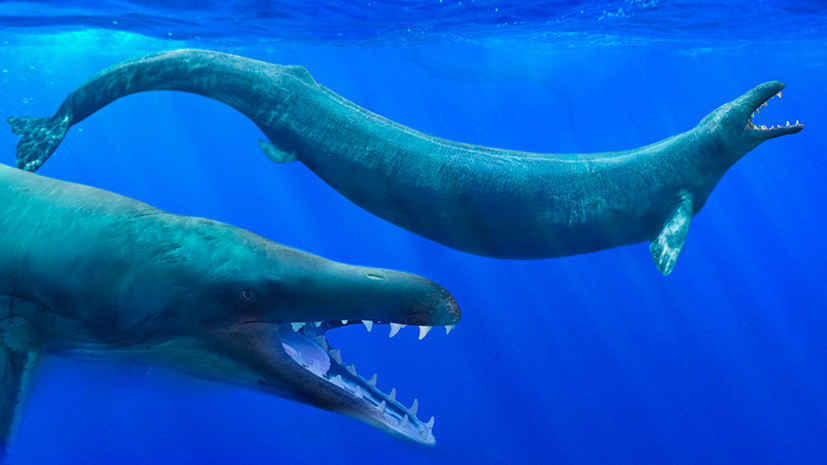
A zeuglodont called "basilosaurus."
![]()
The largest species
of sea turtle known to science was the extinct Archelon ischyros,
measuring roughly 12 ft. long. As large as this species was, reports exist
in modern times of sea turtles attaining much larger dimensions. In the
third century A.D., an eyewitness observer named Aelian said that immense
turtles existed in the Indian Ocean, which reached up to 24 ft. long. In
1154 a El Edrisi of Sri Lanka reported that female turtles up to 30 ft.
long swam that region as well.
The most spectacular account comes to us
from 1883. The captain and crew of the schooner Annie L. Hall while
on an ocean voyage sighted a turtle so colossal that they at first mistook
it for a capsized ship, floating upside down. Upon a closer approach, they
discovered to their astonishment a monster turtle at the surface - 40 ft.
long, 30 ft. wide, and with 20 ft. long flippers (material taken from
"In Search Of Prehistoric Survivors" by Dr. Karl Shuker).
Australia has its own
version of the "Loch Ness Monster". Lake Galilee in far western Queensland
has been the scene of eerie happenings and numerous disappearances since
last century. Livestock drinking at the lake's edge have vanished without
a trace, as have the occupants of fishing boats which have overturned or
been found smashed. Large dark shapes have been reported moving through
the dismal waters.
Long before the arrival of Europeans, the local
Aborigines had ceased to settle on the shores because a giant, man-eating
"bunyip" lived in the lake. It grabbed anyone who dared to take his canoe
out on the water, or was foolish enough to wade in the shallows.
Oral tradition describes the monster as being six
to nine meters (20 to 30 feet) long. It has a long, serpentine neck attached
to a large, bulky body, a long eel-like tail and two pairs of large flippers
used for propulsion.
A former missionary to the area had a tribal elder
tell him of this animal from the oral traditions. This elder also drew
for the missionary a picture of the creature, which bears a striking resemblance
to a plesiosaur (below), which evolutionists say died out millions of
years ago:
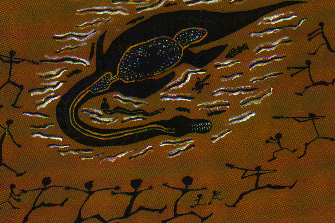
[Australian material taken from Creation ex nihilo, vol. 21, no. 1]
Everyone probably remembers
the terrifying great white shark of the movie Jaws. Yet this shark
species had a larger brother, aptly named the giant white shark,
or megalodon. Based on recovered teeth from this shark (its
skeleton was composed of cartilage, which decomposes, leaving only the
teeth), its official length was estimated at 40-55 ft. long, compared to
20-25 ft. for the great white shark. Megalodon is thought by evolutionists
to have died out millions of years ago.
In 1927, author Zane Grey spied a huge, slate-grey
colored shark while sailing in the South Pacific, and measuring considerably
more than his 35-40 ft. boat. In 1933, Grey's son, while sailing northwest
of Rangiroa, also sighted a titanic shark, its head alone measuring an
estimated at 10-12 ft. across, and its total length around 40-50 ft. long.
Unlike the speckled spots of the whale shark (a plankton feeder and the
largest known fish in the sea today), this shark was yellowish in color.
The fishermen of New South Wales tell of a great
fish which frequents their waters, which they refer to as "the Lord of
the Deep." They tell of an enormous shark, far larger than a whale shark,
which is able to tow away their extremely heavy crayfish pots, strung together
and lying on the ocean floor, which are 3-4 ft. long. The fishermen report
that the shark is white, and they estimate its length to be from 115-300
ft. long!
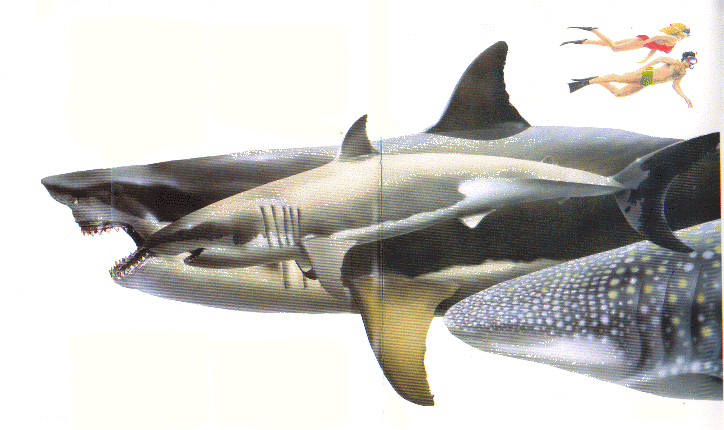
[A megalodon, or giant white shark, swimming behind a great white and basking shark; drawing taken from "Giants" by David Peters]
An extinct form of sea scorpion once inhabited the ocean floors, and they are thought by evolutionists (not creationists) to have died out millions of years ago. However, on March 11, 1959, diver Bob Wall was diving in 35 ft. of water off the coast of Miami, Florida, and encountered an underwater cave. As he began to explore within, he was met by a creature with a 5 1/2 ft. body, elevated by eight hairy legs, and a pointed head whose stalked, dollar-sized eyes were looking directly at him, at which point he fled to the surface.
| A similar creature was found, of all places, from the bottom of a 12-ft.-deep well on an Indiana farm. In 1960, the farm owner Dan Craig told of the bizarre inhabitant which was "....an eerie beast with a dome-shaped head, two bulbous eyes, and eight flailing tentacles as long as a man's arm." It was said to resemble a mushroom as large as a plate, with long legs and feet (Ibid, pp. 123-124). |
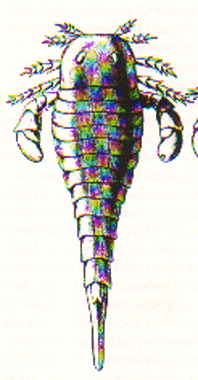
|
In Antelope Springs, Utah, in 1968, fossilized sandal prints were discovered. "One print had a squashed trilobite embedded in it. According to paleontology, this would indicate that someone was walking about in sandals more than 500 million years before man is supposed to have evolved." ("The People's Almanac" by Wallechinsky and Wallace, p. 1344). [Eat the writer of this piece only considers the possibility that man might have lived millions of years ago with a trilobite, not that perhaps the earth is young and trilobites and man lived together, since that would undercut the religion of evolution, which must be embraced at all costs by those who reject the Bible and the authority of Genesis, it would s